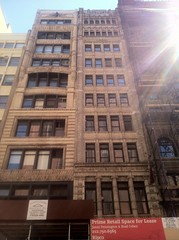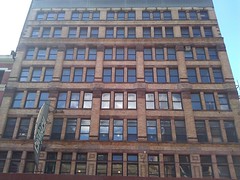The Local has discovered that Joseph Chetrit, the real estate mogul who last night faced Community Board 4’s disapproval of his controversial plan to bring a rooftop extension to the Hotel Chelsea, plans to convert an office building at 708 Broadway into another hotel. As with the Chelsea, the developer is seeking to add another story to the building at Broadway between East Fourth Street and Washington Place. An application filed with the Department of Buildings on Tuesday estimates that the conversion will cost a little over $9.5 million.
The application proposes that 127,064 square feet of space in the building, which comprises ten stories on the Broadway side and eight stories on the 404 Lafayette Street side, be divided into 249 units. Gene Kaufman, the architect who is also working on the Chelsea’s renovation, is listed as the applicant of record. Neither Mr. Kaufman nor the notoriously press-shy Mr. Chetrit have responded to The Local’s interview requests.
In an item about the controversy over the penthouse addition at the Hotel Chelsea, The Observer said that Mr. Chetrit “might be the most secretive big-time developer in a city full of the type.” He bought the Chelsea in August and closed it to guests; shortly after, a tattoo parlor in the hotel was asked to leave and artwork disappeared from the walls. In December, permanent tenants brought a lawsuit against the developer alleging that renovations at the hotel were creating hazardous conditions. And in January, Patti Smith canceled a planned concert at the hotel in order to appease tenants complaining about eviction attempts.
Mr. Chetrit, whose company also redeveloped the Empire Hotel near Lincoln Center, won’t face similar resistance from tenants at 708 Broadway, which he acquired for $39.5 million in 2005: the building, home in the past to Workman Publishing, Jivamukti Yoga School, and the American Indian Community House, appears to be pretty much vacant, though Crunch gym is still in business on the Lafayette side. (When the building’s owner first sought to remove partitions in the building in 2008, a Stop Work order was issued for construction without a permit.) But as with the Chelsea, he’ll have to plead his case to the Landmarks Preservation Commission. Built to house lofts and stores in 1896, the Northern Renaissance Revival building was designed by Cleverdon & Putzel, who also designed the Astor Building at 583 Broadway and various loft buildings on Great Jones and Bond Streets.
If green-lighted, the hotel would be just a couple of blocks away from the Bowery Hotel and the new Standard East Village.
The application, currently being examined by the Buildings Department, is the second one in recent weeks to propose a rooftop extension in NoHo. A couple of blocks from the forthcoming hotel, the owner of 45 Great Jones Street hopes to add two new floors to the former Great Jones Lumber building.
Zella Jones, president and C.O.O. of the newly formed NoHo-Bowery Stakeholders, estimated that it would be a few months before plans for that building’s residential conversion were solidified. “Noho-Bowery Stakeholders and the new owning corporation are sitting down in the architect’s office and will be discussing what may be built there,” she said during a phone interview. “There are maybe a dozen different scenarios and all of the property owners on Great Jones and Bond Streets are going to be sitting down with the corporation’s owners to talk about it.”
Ms. Jones didn’t anticipate much conflict. “The bottom line here is that this is a very friendly development and a very cooperative developer compared to some others we’ve had around here,” she said. “They are very supportive of NoHo and its landmarks and they’re not looking to rock the boat here.”





